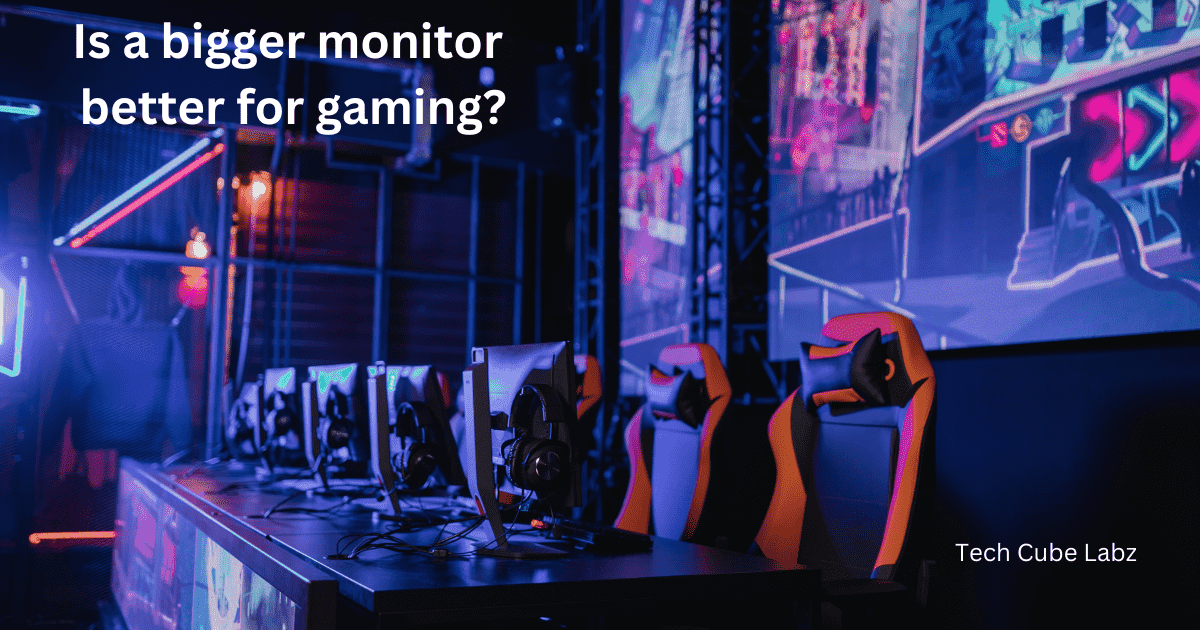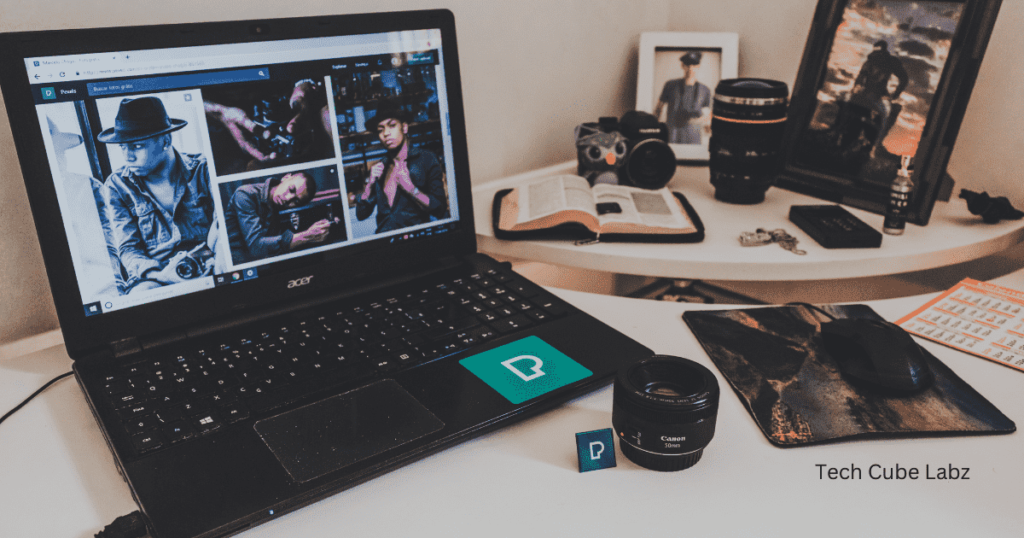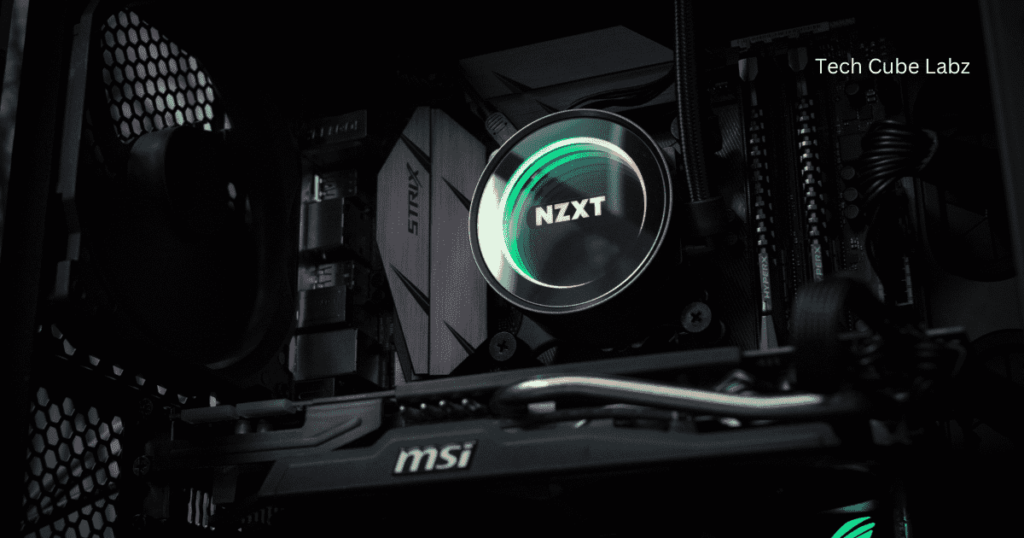
Is a bigger monitor better for gaming?: A larger screen is considered better. Most people would choose a TV with a screen size of 100 inches over one that is 50 inches, right? This desire for larger screens can be a problem for PC gamers.
The push for the biggest screen seems logical. Immersion is key to a great gaming experience, and an expansive monitor is the perfect canvas for painting vivid game worlds. But there’s a critical juncture where the scale tips from beneficial to burdensome.
Just ask anyone who has decided to use a 55-inch TV as their PC gaming monitor at a desk! There’s definitely such a thing as “too big,” and the dividing line might be closer to the smaller end of the monitor market than you might think.
Your high-resolution game deserves a quality display. Pixel density is often ignored, but it plays an important role in producing crisp and clear images. A larger screen with no increase in resolution will result in a diluted density of pixels, which can give your game a mosaic appearance.
Then, there is the issue of viewing distance. It might seem like a great idea to have a cinema-sized screen on your desk. Still, it will make you strain your neck and eyes because there is not enough room for you to view the monitor comfortably.
It would help if you also considered how you use your gaming monitor when playing at your desk. A smaller monitor (e.g., A monitor of 24 or 27 inches will cover the same area as a large monitor at a closer viewing distance.
9 best bigger size monitor is better for gaming
- Samsung Odyssey G9
- LG UltraGear 38GN950-B
- Acer Predator X38
- ASUS ROG Swift PG43UQ
- Dell Alienware AW3821DW
- Samsung Odyssey G7
- MSI Optix MAG342CQR
- LG 34GN850-B
- AOC CU34G2X
1. Samsung Odyssey G9
The Samsung Odyssey G9 and other monitors of its kind are probably not the first things that come to mind when you think about the top gaming monitors. In a world where 16:9 screens and 1080p refresh rates are the norm, having a monitor that’s so full-on is refreshing.
The Samsung Odyssey G9 gaming monitor is a beast. It has a 49″ display, 5,120 x 1440 resolution, and 240Hz. This is everything you can ever want in a monitor. It’s likely why the price is so high at $1,479 ($1,289 in PS, $2,799).
The Samsung Odyssey G9 offers many of the same features as Asus’ top-notch gaming monitor: G-Sync, HDR 1000 compatibility and 125% coverage of sRGB colors. The Samsung Odyssey G9, at its best, is a stunning monitor.
However, there is one possible annoyance. The QLED screen is divided into three sections due to the way it operates. If, for example, there is a small icon on the corner, then a third of the screen will be lit, and the rest will be dark. It’s not something you will see 99% of the time, but it is still something to keep in mind.
The colors in HDR games such as Destiny 2 are simply stunning, especially while exploring the dark caverns of the underground, where guns and abilities contrast sharply with the darkness. This monitor is the best of all. [Is a bigger monitor better for gaming?]

2. LG UltraGear 38GN950-B
The LG UltraGear 28GN950 is a gaming monitor that measures 38 inches wide. It features a Nano IPS display with vibrant colors, a quick response time and a high refresh rate of 160Hz.
The UltraGear 38GN950 is based on LG’s nano IPS display with 178-degree viewing angles dit, here 10-bit depth (1.07 trillion colors), and a wide 98% DCI P3 color gamut, which is equivalent to 135% of sRGB.
The sRGB profile is also included in the package if you want a more accurate color reproduction when working on professional projects or using native sRGB (most web and video content) content.
Select’sRGB” from the Game Mode Settings in the OSD menu (On-Screen display) to activate this profile. This mode allows you to adjust brightness, which is great.
The 37.5″ display is perfectly suited to the screen resolution of 3840×1600. You get a lot of screen space and crisp details with 111 pixels/inch.
This resolution can be quite demanding, so ensure that your PC is able to produce a frame rate in video games that you are satisfied with.
This format gives you more horizontal space on the screen, which can be very useful for productivity. The extended field of vision also allows for a more immersive experience when playing games. The 21.9% aspect ratio also makes movies look better. [Is a bigger monitor better for gaming?]
Read Also: How do I make my bedroom a smart room?
3. Acer Predator X38
Back in May 2021, Acer announced a refresh of their high-end Predator X38 P gaming monitor, the Acer Predator X38 S.
The new display was said to offer performance-enhancing features that would put it head and shoulders above its predecessor, sparking a new wave of excitement for an already popular ultrawide gaming monitor.
The Predator X38 S is equipped with the same basic features as its predecessor. This includes a 175 Hz IPS panel and a 37.5″ IPS screen.
The new X38 S also boasts a faster GTG reaction time and 750-nit maximum brightness. It is also VESA DisplayHDR600 certified.
The X38 S also boasts a 1000:1 dynamic contrast ratio, a 2300R ultrawide display and a 98% DCI P3 color gamut, exceeding the minimum requirements to experience HDR.
The Acer X38 S is packaged in a brown box with a few images of the panel, along with the main features and specifications.
The X38 S monitor is fully protected inside by two large styrofoam pieces. This ensures that no damage will occur during transport. The monitor is fully assembled and ready to use. [Is a bigger monitor better for gaming?]

4. ASUS ROG Swift PG43UQ
We haven’t tested an HDR1000 display from ASUS for a long time. It was a big screen, Ultra HD at 144Hz, without any Chroma Subsampling problems. The ASUS ROG Swift PG43UQ, a 43-inch beast, is here.
This 43″ screen will be used to show off Ultra HD and HDR gaming. This means a native resolution of 3840×2160 pixels on a VA panel capable of 144Hz, G SYNC compatibility and FreeSync mode. This monitor has a big DCS label.
There are no chroma-subsampling problems (Display Stream compression) supported. DSC allows 4K HDR to be transferred at 144Hz using a DisplayPort 1.4 connector.
Monitors without DSC can only achieve 98 Hz when running 4K with 4:4:4 and HDR. We’ll discuss this in more detail on the following page. Let’s first list some of the main features that this monitor has.
The release of this screen series was delayed for years, but we finally have a look at it. The screens are HUGE Ultra HD and can achieve a peak brightness of HDR1000 when used with G-Sync/FreeSync. The trend in monitors is HDR (local dimming has also gained popularity) and Ultra HD.
HDR has, however, been a confusing subject to discuss, with some monitors labeled as “HDR compatible” offering laughable amounts of nits within the 300350 cd/m2 region. [Is a bigger monitor better for gaming?]
Read Also: Which gadget is best for students?
5. Dell Alienware AW3821DW
Another day, another gaming monitor. Do not bet on this! Alienware, Dell’s gaming-focused division for many years, has created a massive panel that is impossible to ignore.
The $1,459 Alienware Curved Gaming Monitor AW3821DW is a large, beautiful display with a WQHD+ resolution (3,840 x 1,600 pixels in 21:9). It aims to deliver an immersive gaming and cinematic experience.
The display is impressive in print and even more so when you see it, but the input lag results and HDR tests fell short of what we expected for this price.
This is a good monitor, but it doesn’t stand out as much as Alienware’s other products, such as the excellent (though slightly smaller) Alienware 32 QD-OLED.
It’s only natural for large monitors, like the Alienware 38, to take up a great deal of desk space. The front of the 38-inch screen has a thin bezel in black, without any embroidery geared towards gamers.
The monitor is clean, with only the Alienware Logo in the middle. The stand is sturdy and can be adjusted to a height of 5.1 inches. It also swivels around 40 degrees. [Is a bigger monitor better for gaming?]

6. Samsung Odyssey G7
The Samsung Odyssey G7 could be the perfect display for gamers who want to avoid FOMO. This is because the market for the top gaming monitor is divided into two distinct categories that are based on the genres of games you play and the way you wish to maximize your experience.
The 1000R screen is a particular standout, with a curve that would make Beyonce jealous. Even if you’re used to curved displays, it may take some time to get used to the 1000R screen. This creates a sense of immersiveness in games such as Elite Dangerous or Subnautica.
The standard desktop will indeed require some adjustment to use outside of gaming. Still, after a couple of days, we were able to get over the “fishbowl” feeling.
Samsung’s decision to use a vertical alignment (VA) panel might have raised eyebrows, too, given that the technology is often associated with problems like ghosting, motion blur and lag.
However, we did not experience any of these issues during our tests. You could easily mistake it for an IPS display, given the vibrant colors and high contrast. [Is a bigger monitor better for gaming?]
7. MSI Optix MAG342CQR
The MSI Optix MAG271CQR monitor is a 1440p VA panel with a good design. The monitor delivers great gaming performance with a low input lag and an excellent response rate.
It also supports AMD’s FreeSync technology, which allows for virtually tear-free gaming. The unit we tested had a terrible uniformity of black, and the image degraded when viewed from an angle, like most VA monitors. It may be difficult to position the stand in an optimal viewing position because it has a limited range.
The MSI Optix MAG271CQR monitor is a good choice for most users. The monitor is designed for gaming and delivers an excellent gaming experience. It’s not very versatile, however, due to its limited ergonomics and poor viewing angles.
Other models are available. Some of them are listed below. Our review is not valid for other models.
Please let us know if you come across a different panel type or if your MAG271CQR does not match our review. We will update it. Please note that individual units may differ in some tests, such as the grey uniformity.
The LG Optix MAG271CQR and the 27GL850B/27GL83AB use different panel technologies, with each having its own strengths and weaknesses. The MSI is better for dark rooms because it has a better contrast.
However, the LG offers better viewing angles and supports HDR. The Optix offers an optional black-frame insertion feature and has better handling of reflections. [Is a bigger monitor better for gaming?]

8. LG 34GN850-B
What is the price of a 34-inch gaming monitor with all its features? That will be $1,000/PS1,000. The LG UltraGear 32GN850 is priced at $995, which is around the PS969 (AU $1,630) mark. This is a lot of money, and the monitor better be good.
It certainly checks off a lot of boxes. The 34-inch panel has a 3,440 by 1,440-pixel resolution. LG’s Nano IPS display is a little special, even if it’s expected. LG claims that it has a response time of 1 ms, which is on par with the best TN screens. Impressive.
You also get a 160 Hz refresh rate, Nvidia FreeSync, and AMD G-Sync support. G-Sync is G-Sync Verified, not the more advanced G-Sync offering based on Nvidia’s in-monitor imaging chipset.
You ask, “What about HDR?” The LG UltraGear 32GN850 has it, but the specs are a bit lacking given its high price.
Only VESA DisplayHDR400 is certified. This is the lowest level of HDR certification. The 34GN850 is not equipped with local dimming, and its maximum brightness is 400 nits.
The omission of USB Type-C is another disappointment. Indeed, USB-C may not be a priority for gamers who are more likely to connect this panel to a desktop computer.
Some gamers do use portables, and for some, it will be a disappointment to not have the option of charging, connecting peripherals, and driving the display with one cable. [Is a bigger monitor better for gaming?]
9. AOC CU34G2X
The AOC G Line 3rd Gen is the latest model in AOC’s G Line gaming monitor series. It offers a great experience at a reasonable price.
This is a good choice for gamers looking for a high refresh rate with a responsive display, but who don’t want to spend more than $1000.
The Samsung Odyssey G7 has a refresh rate and response time of 1 ms, but the resolution is just a little short of 4K, at 3440 x 1440. It displays 16.7 million colors and has a brightness rating of 300 nits.
It’s not only an ultrawide monitor with a 21:9 aspect ratio, but it is also curved. It keeps all of the action in front of your eyes, so you don’t have to turn your head to see all the details. This monitor is great for lower-end PCs because it offers near 4K but not quite.
The design and color are standard in the industry, but the curved screen with its extremely thin bezels means you get all 34 inches.
The curved screen and extremely thin bezels make it look sleek, even though there is no RGB backlighting. The port selection of the device is also impressive, with two HDMI ports, a headphone jack 3.5mm, two Display Ports 1.4 and two USB Type-A ports. [Is a bigger monitor better for gaming?]

Conclusion:
The best large-sized monitors for gaming depend on a number of factors, including the resolution, refresh rate and panel type. The Samsung Odyssey G9 is a large-screen monitor with high resolution and a high refresh rate. It’s perfect for immersive gaming.
For those who want a smaller screen, the LG ultraGear 38GN950B or Acer PredatorX38 provide excellent performance and high resolutions. For gamers who want large screens, the ASUS RoG Swift PG43UQ or HP Omen X 65 Emperium are ideal.
They offer 4K resolutions and HDR compatibility. Select the monitor that fits your needs based on your gaming requirements, your budget, and your space. [Is a bigger monitor better for gaming?]
Is a bigger monitor better for gaming?: FAQ
1. Are smaller or bigger monitors better for gaming?
Ans: For the best experience, we recommend a minimum of a 22″ gaming monitor with 720p resolution. However, if you can afford it, ideally, sizing your screen to 24 inches is recommended. For more immersion, some users might choose a larger 27-inch screen size. However, this may feel stretched out. This may be fine for those who have not used a 27-inch 2K gaming display.
2. Is a 32-inch monitor too big for gaming?
Ans: No. If the screen resolution is 4K or greater, a 32-inch monitor will provide an immersive gaming experience.
3. Why do pro gamers use small monitors?
Ans: It is easier to practice on a smaller screen for professional gamers.
